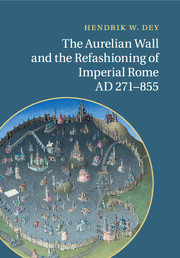Book contents
- Frontmatter
- Contents
- List of abbreviations
- List of figures
- Acknowledgements
- Introduction
- 1 Toward an architectural history of the Aurelian Wall, from its beginnings through the ninth century
- 2 Planning, building, rebuilding, and maintenance: the logistical dynamics of a (nearly) interminable project
- 3 Motives, meaning, and context: the Aurelian Wall and the late Roman state
- 4 The city, the suburbs, and the Wall: the rise of a topographical institution
- 5 Sacred geography, interrupted
- 6 The Wall and the “Republic of St. Peter”
- Conclusion
- Appendices
- Bibliography
- Index
3 - Motives, meaning, and context: the Aurelian Wall and the late Roman state
Published online by Cambridge University Press: 19 May 2011
- Frontmatter
- Contents
- List of abbreviations
- List of figures
- Acknowledgements
- Introduction
- 1 Toward an architectural history of the Aurelian Wall, from its beginnings through the ninth century
- 2 Planning, building, rebuilding, and maintenance: the logistical dynamics of a (nearly) interminable project
- 3 Motives, meaning, and context: the Aurelian Wall and the late Roman state
- 4 The city, the suburbs, and the Wall: the rise of a topographical institution
- 5 Sacred geography, interrupted
- 6 The Wall and the “Republic of St. Peter”
- Conclusion
- Appendices
- Bibliography
- Index
Summary
The preceding look at the immense logistical hurdles inherent in the construction and maintenance of the Aurelian Wall raises another query as yet insufficiently explored, for all (or perhaps because of) its apparent obviousness: why was the thing built in the first place, and subsequently so laboriously rebuilt and renovated? As it turns out, the question of what the Wall was supposed to do is rather less straightforward than it might seem; and “defense,” the preferred response to date, provides only a partial explanation. Although the political and strategic military dynamics of the late empire cannot be overlooked, they are perhaps more usefully seen as the foundation for the “what for?” inquiry, rather than the final word. The same can be said for the treatment of the Wall in its broader context, as part of a widespread spate of wall-building during the later third, fourth, and fifth centuries that culminated in an empire-wide revamping of classical urban paradigms. While the Wall's place in this process requires further assessment, both to elucidate the rationale for its construction, and to better establish the nature of its influence upon the development and subsequent proliferation of urban fortifications in late antiquity, the truly exceptional nature of both the monument and the city of Rome itself cannot be overstated. The fortification of the caput mundi was, in both practical and conceptual terms, an unparalleled endeavor.
- Type
- Chapter
- Information
- Publisher: Cambridge University PressPrint publication year: 2011



